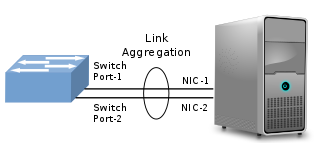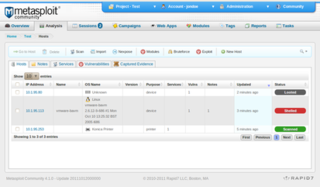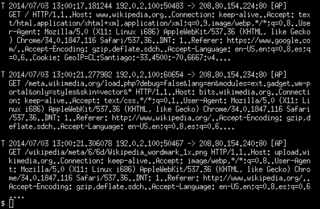
A packet analyzer, also known as packet sniffer, protocol analyzer, or network analyzer, is a computer program or computer hardware such as a packet capture appliance that can analyze and log traffic that passes over a computer network or part of a network. Packet capture is the process of intercepting and logging traffic. As data streams flow across the network, the analyzer captures each packet and, if needed, decodes the packet's raw data, showing the values of various fields in the packet, and analyzes its content according to the appropriate RFC or other specifications.
An intrusion detection system is a device or software application that monitors a network or systems for malicious activity or policy violations. Any intrusion activity or violation is typically either reported to an administrator or collected centrally using a security information and event management (SIEM) system. A SIEM system combines outputs from multiple sources and uses alarm filtering techniques to distinguish malicious activity from false alarms.

tcpdump is a data-network packet analyzer computer program that runs under a command line interface. It allows the user to display TCP/IP and other packets being transmitted or received over a network to which the computer is attached. Distributed under the BSD license, tcpdump is free software.
In computer networking, promiscuous mode is a mode for a wired network interface controller (NIC) or wireless network interface controller (WNIC) that causes the controller to pass all traffic it receives to the central processing unit (CPU) rather than passing only the frames that the controller is specifically programmed to receive. This mode is normally used for packet sniffing that takes place on a router or on a computer connected to a wired network or one being part of a wireless LAN. Interfaces are placed into promiscuous mode by software bridges often used with hardware virtualization.

Snort is a free open source network intrusion detection system (IDS) and intrusion prevention system (IPS) created in 1998 by Martin Roesch, founder and former CTO of Sourcefire. Snort is now developed by Cisco, which purchased Sourcefire in 2013.

KisMAC is a wireless network discovery tool for Mac OS X. It has a wide range of features, similar to those of Kismet. The program is geared toward network security professionals, and is not as novice-friendly as similar applications. Distributed under the GNU General Public License, KisMAC is free software.

In computer networking, link aggregation is the combining of multiple network connections in parallel by any of several methods. Link aggregation increases total throughput beyond what a single connection could sustain, and provides redundancy where all but one of the physical links may fail without losing connectivity. A link aggregation group (LAG) is the combined collection of physical ports.
NetStumbler was a tool for Windows that facilitates detection of Wireless LANs using the 802.11b, 802.11a and 802.11g WLAN standards. It runs on Microsoft Windows operating systems from Windows 2000 to Windows XP. A trimmed-down version called MiniStumbler is available for the handheld Windows CE operating system.
In the field of computer network administration, pcap is an application programming interface (API) for capturing network traffic. While the name is an abbreviation of packet capture, that is not the API's proper name. Unix-like systems implement pcap in the libpcap library; for Windows, there is a port of libpcap named WinPcap that is no longer supported or developed, and a port named Npcap for Windows 7 and later that is still supported.

Wireless security is the prevention of unauthorized access or damage to computers or data using wireless networks, which include Wi-Fi networks. The term may also refer to the protection of the wireless network itself from adversaries seeking to damage the confidentiality, integrity, or availability of the network. The most common type is Wi-Fi security, which includes Wired Equivalent Privacy (WEP) and Wi-Fi Protected Access (WPA). WEP is an old IEEE 802.11 standard from 1997. It is a notoriously weak security standard: the password it uses can often be cracked in a few minutes with a basic laptop computer and widely available software tools. WEP was superseded in 2003 by WPA, a quick alternative at the time to improve security over WEP. The current standard is WPA2; some hardware cannot support WPA2 without firmware upgrade or replacement. WPA2 uses an encryption device that encrypts the network with a 256-bit key; the longer key length improves security over WEP. Enterprises often enforce security using a certificate-based system to authenticate the connecting device, following the standard 802.11X.
Monitor mode, or RFMON mode, allows a computer with a wireless network interface controller (WNIC) to monitor all traffic received on a wireless channel. Unlike promiscuous mode, which is also used for packet sniffing, monitor mode allows packets to be captured without having to associate with an access point or ad hoc network first. Monitor mode only applies to wireless networks, while promiscuous mode can be used on both wired and wireless networks. Monitor mode is one of the eight modes that 802.11 wireless adapter can operate in: Master, Managed, Ad hoc, Repeater, Mesh, Wi-Fi Direct, TDLS and Monitor mode.

The Metasploit Project is a computer security project that provides information about security vulnerabilities and aids in penetration testing and IDS signature development. It is owned by Boston, Massachusetts-based security company Rapid7.
hostapd is a user space daemon software enabling a network interface card to act as an access point and authentication server. There are three implementations: Jouni Malinen's hostapd, OpenBSD's hostapd and Devicescape's hostapd.

Aircrack-ng is a network software suite consisting of a detector, packet sniffer, WEP and WPA/WPA2-PSK cracker and analysis tool for 802.11 wireless LANs. It works with any wireless network interface controller whose driver supports raw monitoring mode and can sniff 802.11a, 802.11b and 802.11g traffic. Packages are released for Linux and Windows.

Wireshark is a free and open-source packet analyzer. It is used for network troubleshooting, analysis, software and communications protocol development, and education. Originally named Ethereal, the project was renamed Wireshark in May 2006 due to trademark issues.
Packet injection in computer networking, is the process of interfering with an established network connection by means of constructing packets to appear as if they are part of the normal communication stream. The packet injection process allows an unknown third party to disrupt or intercept packets from the consenting parties that are communicating, which can lead to degradation or blockage of users' ability to utilize certain network services or protocols. Packet injection is commonly used in man-in-the-middle attacks and denial-of-service attacks.

Network Security Toolkit (NST) is a Linux-based Live DVD/USB Flash Drive that provides a set of free and open-source computer security and networking tools to perform routine security and networking diagnostic and monitoring tasks. The distribution can be used as a network security analysis, validation and monitoring tool on servers hosting virtual machines. The majority of tools published in the article "Top 125 security tools" by Insecure.org are available in the toolkit. NST has package management capabilities similar to Fedora and maintains its own repository of additional packages.
Network detectors or network discovery software are computer programs that facilitate detection of wireless LANs using the 802.11b, 802.11a and 802.11g WLAN standards. Discovering networks may be done through active as well as passive scanning.

ngrep is a network packet analyzer written by Jordan Ritter. It has a command-line interface, and relies upon the pcap library and the GNU regex library.
Sagan is an open source (GNU/GPLv2) multi-threaded, high performance, real-time log analysis & correlation engine developed by Quadrant Information Security that runs on Unix operating systems. It is written in C and uses a multi-threaded architecture to deliver high performance log & event analysis. Sagan's structure and rules work similarly to the Sourcefire Snort IDS/IPS engine. This allows Sagan to be compatible with Snort or Suricata rule management softwares and give Sagan the ability to correlate with Snort IDS/IPS data.











